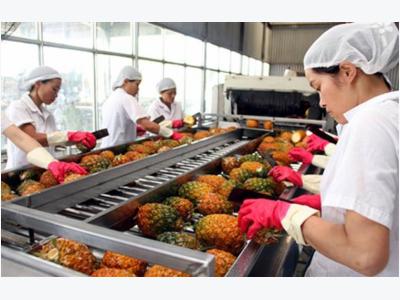Why do the exports sharply increase?

Many commodity groups had high growth, bringing the Vietnam's export turnover in February, 2017 as well as in the first two months of 2017 to double-digit growth of 28.6% and 15.4% respectively.
Vegetables have good growth, up by more than 30%.
Many commodities reached a relative growth rate
The report of the Ministry of Industry and Trade showed that the export turnover in February, 2017 was estimated at $US 13 billion, up by 28.6% over the same period in 2016. The export turnover in the first two months of 2017 was estimated at $US 27.3 billion, up by 15.4% over the same period last year.
Of which, the export turnover of the 100% State capital enterprises was estimated at $US 7.6 billion, up by 12.2%; Foreign directly investment enterprises (including crude oil) reached $US 19.7 billion, up by 16.8% over the same period of 2016.
All commodity groups had growth in the past two months, the highest growth rate was fuel and minerals with 49.2%. However, this group accounted for only 1.9%. The second highest growth rate was processed industrial products with 15.5% but accounted for 80.6% of the total export turnover. agricultural, forestry and fishery products increased by 9.9% over the same period and were estimated at $US 3.2 billion.
Specifically, there were many commodity groups reaching good growth rate, helping the export turnover reach the above growth, such as: Vegetables increased by 31.1%, coffee increased by 21.1%, rubber rose by 144%; coal products sharply increased sharply by 1120%, crude oil rose by 46.3%, petrol and oil rose by 45.2%; fertilizers rose by 82%, plastic materials rose by 69.4%, wood products rose by 479.8%, and common metals and metal products rose by 32.8%.
The increase in prices of many commodities was also the reason for the outstanding increase of the export turnover in the first two months of 2017. Compared to the same period last year, the average prices of most commodities increased (cashew kernel rose by 20.3%, coffee rose by 31.9%, rubber rose by 18%, coal rose by 115.5%, and crude oil rose by 61.9%). The increase in export prices has contributed to an increase of about $US 736 million in export turnover.
There were a few commodities with decrease in export prices such as pepper with the sharpest decrease of 21.1%, ore and other minerals with decrease of 48.4% due to the decline in world prices, but the export scale was not large, these decreases did not affect the general export increase.
There were still barriers
However, one shortcoming in the export picture was that the decline in volume for exports of agricultural, forestry and fishery products and fuel and minerals, which showed that Vietnamese enterprises are facing fierce competition in export markets, especially from Cambodia, the Philippines, Bangladesh, and Pakistan. Therefore, long-term solutions should be issued to stabilize export capacity.
In addition, the export markets are increasingly adding the standards for Vietnamese exports such as seafood, rice and vegetables.
Particularly, South Korea required that imported shrimps must be quarantined, Australia still remain the ban on suspension of shrimp and uncooked shrimp imports from Vietnam, affecting Vietnam's exports. Although seafood export turnover continues to increase, mainly due to the increase in price.
Rice exports have also fallen sharply due to the double effect of Vietnam's largest import market that is China set standards for rice imports from ASEAN countries, causing the sharp decrease in Vietnam's exports to this market and together with that is the rice stockpile sale off of Thailand, reducing the world ‘s rice prices.
The export turnover of rice in the first two months of 2017 reached $US 328 million, down both in volume and export value, in which down by 19.5% in volume and 21.4% in value
With these difficulties, the Ministry of Industry and Trade will regularly monitor the economic situation and the fluctuations of the import-export market in order to promptly issue policies before new developments and solutions and specific solutions to remove difficulties for enterprises and promote production and export and market development.
Accordingly, the Ministry of Industry and Trade proposed the Australian Government to consider and soon abandon its ban on suspension of on suspension of shrimp and uncooked shrimp imports, because this ban causes negative impacts on shrimp farming, manufacturing and processing for exports of Vietnam's.
Initially, with technical barriers in exports of rice to China, shrimps to South Korea and Australia, the Ministry of Industry and Trade will enhance the diffusion of new regulations of Korea, China and Australia to enterprises to avoid disadvantages for exports of shrimp and rice of Vietnam.
In the medium and long term, we need to well prepare the organization of agro-aquaculture production process to build more sustainable export capacity.
Related news
 Fruit, veggie exports overtaking rice
Fruit, veggie exports overtaking rice Fruit and vegetable exports have seen significant advances with a presence in nearly 60 foreign markets.
 Vietnam’s pepper faces difficulties because of India’s ban
Vietnam’s pepper faces difficulties because of India’s ban Soon after Vietnam announced a decision to suspend the import of five agricultural commodities from India due to concerns over infectious insects
 Cashew nut exports mostly rely on imported raw materials
Cashew nut exports mostly rely on imported raw materials Cashew nuts are one of Vietnam's key agricultural export commodities. However, this industry is heavily dependent on imported raw materials.